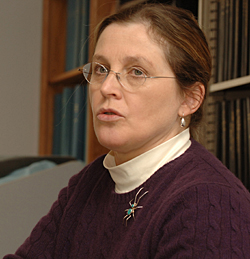“We in the history department are delighted that the Museum Studies Program is now officially part of the department and that we have Kasey Grier as the new director,” Carole Haber, Richards Professor of History and chairperson of the department, said. “Her knowledge of the museum world is great, her scholarship is outstanding and her enthusiasm infectious. Under her guidance, the program will undoubtedly increase its ties to the community and attract the best students. It will surely become the leading academic program in the nation for museum education.”
Grier currently serves as professor of material culture studies for the UD's Winterthur Program in Early American Culture at the Winterthur Museum and Country Estate, where she is the director of its Research Fellows Program and executive editor of Winterthur Portfolio: the Journal of American Material Culture. She received her doctorate from the UD history department's History of American Civilization program and has come full circle and now directs the program.
Grier said she is pleased to be back at UD and is enthusiastic and excited about her new positions and the challenges that lie ahead. “I am looking forward to becoming director of Museum Studies, which is a well-established and respected program. David Shearer (associate professor of history) has done an excellent job as acting director, and I hope to build on his leadership.
“Delaware is a perfect location for such a program as there are an extraordinary number of museums in the region, ranging from small, private museums to those run by the National Park Service. It's even better than Washington, D.C., where most of the museums tend to be large. This area is more representative of the rest of the nation, and one of my goals is building community partnerships,” she said.
Grier said museum studies is a field in which book learning goes only so far, and then students need hands-on experience. She said she hopes to increase opportunities for students to work in museum settings through internships and apprenticeships.
Among her goals, Grier said she wants to reach out to undergraduates as well as graduate students. “By teaching undergraduates and through internships, I hope to create knowledgeable users of museums, who understand their importance and become members and supporters. The program always welcomes graduate students, who are adding another competence to their degrees,” she said.
Although her focus will be on Museum Studies, Grier also will be teaching some history courses, including the capstone course for seniors on “Writing History through Material Culture” and “Introduction to Material Culture” for graduate students.
She also will continue as editor of the Winterthur Journal. “It is the academic journal of material culture and those in the field rely on it for keeping up to date on what's happening in the field and for teaching,” she said.
Before coming to Winterthur, Grier served as associate professor of history at the University of South Carolina and as co-director of its Certificate Program in Museum Management and taught courses in history, research methods, material culture and museums
From 1991-98, Grier was an assistant professor of history and helped establish and served as acting director of the Obert C. and Grace A. Tanner Humanities Center at the University of Utah. She said she learned administrative skills there by writing grants, organizing research projects and special outreach programs for teachers and others.
During her career, she served as the historian of the Strong Museum in Rochester, N.Y., and taught at the State University of New York at Brockport. She also was curator and guest curator of exhibitions in Texas and Pennsylvania.
Grier's field of research centers on the history of everyday life in the United States in the 19th and 20th centuries and mostly recently has focused on the relationships between people and animals. She said she always has been an animal lover, grew up with pets and is now the owner of two dogs, one cat and a tortoise, which goes by the gender-neutral name of Sidney.
She is the author of Pets in America: A History, which looks at pets during the 18th through the 20th century and was guest curator of an exhibit based on her book, “Pets in America: The Story of Our Lives with Animals at Home,” which was shown at seven different venues. She received the Distinguished Scholar Award from the International Association of Human-Animal Interactions Organizations and the International Society for Anthrozoology for her “contribution to the study of human-animal interactions and relationships.”
A graduate of Princeton University, Grier received her master's degree in History Museum Studies Cooperstown Graduate Programs, New York State Historical Association and State University College at Oneonta.
Article by Sue Moncure
Photo by Kathy Atkinson


